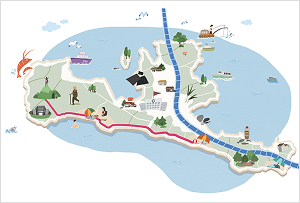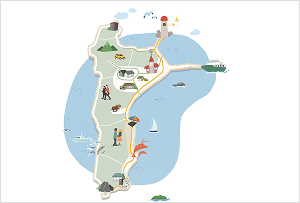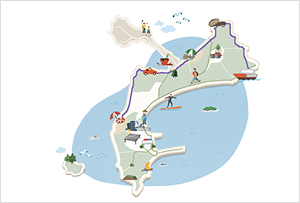-
Wonsando Island 2027 ~ 2033Wonsando Island 2027 ~ 2033
An Island of Travel Where Diverse Beaches and Nature are in Harmony
-
Godaedo Island 2027 ~ 2033Godaedo Island 2027 ~ 2033
A Special Island Where Nature and History Coexist
-
Sapsido Island 2029 ~ 2033Sapsido Island 2029 ~ 2033
An Island of Romance Created by Fantastic Rock Formations, Pine Forests, and the Sea
-
Janggodo Island 2031 ~ 2033Janggodo Island 2031 ~ 2033
A Fishing Village Island with Janggu-shaped Topography and Tidal Flats
-
Hyojado Island 2033Hyojado Island 2033
An Island of Rest in a Serene Landscape


| Total Households | Total Population | Total Area(㎡) | Coastline Length(km) |
|---|---|---|---|
| 511 | 999 | 7,070,000 | 28.6 |
| Key Features |
|
||
Wonsando island is rare on Korea’s west coast for its south-facing beaches and is popular as a family vacation spot. The island is ideal for summer holidays, featuring Wonsando Beach and Obongsan Beach, and the path to Obongsan Beach is a popular trekking course. Sea fishing experiences offer a unique pleasure found only on Wonsando island.
With the opening of the Wonsan–Anmyeon Bridge (December 2019) and the Daecheon–Wonsando Undersea Tunnel (late 2021), the island can now be reached conveniently by car without a ferry. Wonsando island is newly spotlighted as a family destination where visitors can relax in nature while enjoying diverse leisure activities.


| Total Households | Total Population | Total Area(㎡) | Coastline Length(km) |
|---|---|---|---|
| 112 | 218 | 870,000 | 6.0 |
| Key Features |
|
||
Godaedo island was settled early, forming villages on the island; it boasts abundant marine resources and pristine fishing grounds. Clams and oysters can be harvested easily across the island, and the sea is so clear that the water is visibly transparent. Its designation along with adjacent Jangodo island as part of Taeanhaean National Park further enhances its value.
Godaedo island is also the historic site of Korea’s first Christian mission. Records note that German missionary Karl Gutzlaff brought potato seeds and shared cultivation methods with impoverished Joseon people, making Godaedo island even more distinctive.
With beautiful scenery and deep history, Godaedo island offers visitors a richer, more moving experience.


| Total Households | Total Population | Total Area(㎡) | Coastline Length(km) |
|---|---|---|---|
| 242 | 387 | 3,780,000 | 14.3 |
| Key Features |
|
||
Named for its bow-and-arrow shape, Sapsido island is a beautiful destination where striking vistas blend with lush pine groves.
The island has three treasured landmarks: Hwanggeum Gomsol (Golden Pine), Mulmangteo Spring, and Myeonsapji Beach. Exploring these sites along the coast and walking the pine-forest trail leads to scenic observatories and village alleys. In particular, the Sapsido Dulle-gil (coastal trail) connects the southernmost and northernmost villages, offering a faithful experience of the island’s nature and fishing-village scenery.
A trip to Sapsido island, walking, resting, and staying amid pristine nature, will be a special time to recharge body and mind.


| Total Households | Total Population | Total Area(㎡) | Coastline Length(km) |
|---|---|---|---|
| 132 | 262 | 1,500,000 | 9.5 |
| Key Features |
|
||
Jangodo island, named for its drum-like shape, is a typical fishing village where most residents engage in fisheries. At dawn, fishermen and divers return with their boats, the village comes alive, and you can see fresh catches being sorted and abalone and sea cucumbers being harvested.
Shallow waters, mudflats, and reefs around the island support abundant coastal fish stocks. As a result, it is known as a pristine fishery where abalone and sea cucumbers are farmed, along with anchovies, sand eels, whitebait, and seaweed.
Jangodo island also preserves folk games and local rites such as Deungbarunori, Deungbul-sseogi, and Jindae Seonangje. Its coast, famed for striking rock formations and white sands with green pines, is part of Taeanhaean National Park.
With rich marine resources, long-standing traditions, and beautiful nature, Jangodo island offers an authentic experience of a Korean fishing village.


| Total Households | Total Population | Total Area(㎡) | Coastline Length(km) |
|---|---|---|---|
| 73 | 127 | 1,000,000 | 5.6 |
| Key Features |
|
||
Hyojado island faces Wonsando island and is home to modest fishing villages such as Araetmal, Utmal, Myeongdeok, and Noksaji; fishing is the main occupation.
Its signature attraction is a pebble beach of rounded stones stretching about 2km. The wave-polished, palm-sized pebbles offer a pleasant tingle underfoot, and the dense pine woods behind the beach are ideal for camping and picnics. In adjacent Myeongdeok Village, visitors can enjoy homestays that capture the simple charm of a fishing village.
At night, lights from the Boryeong Thermal Power Plant across the sea softly illuminate the beach, making it perfect for a romantic midsummer stroll with family or a loved one.





